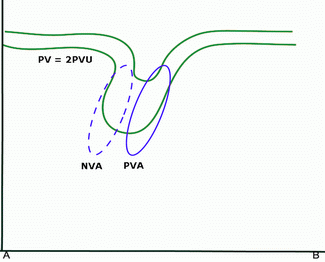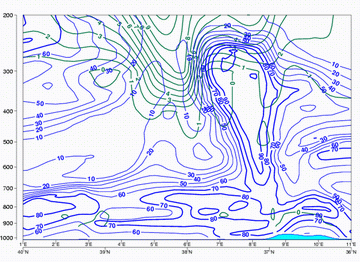Typical Appearance In Vertical Cross Sections
One of the most distinct features is a pronounced lowering of the PV-2 unit to heights of 400-500 hPa. This lowering of the dynamical tropopause
is regarded to as the upper level PV anomaly (see also
Additional Parameters Indicative Of The Diagnosis Of Cloudiness: Potential Vorticity
).
If this anomaly propagates over time, then ahead of the anomaly, positive vorticity advection occurs and to the rear, there is negative
vorticity advection.
A large area of cold advection can very often be found near the PV anomaly. There is a forward tilt of the advection pattern, resulting in increasing cold advection with height (and therefore destabilisation). To the rear of the PV anomaly, an area of warm advection can often be found which may indicate an approaching new frontal system.
Just below the PV anomaly, at mid-tropospheric levels, the strongest upward and downward motion can be found.
Although cold advection and the vorticity advection tend to counteract each other, a maximum of upward motion can be detected, indicating that
the contribution of vorticity advection must be larger than that of temperature advection. (see also
Numerical Parameters Indicative Of The Production Of Cloudiness: Omega Equation
).
A sharp gradient of isentropes near the surface indicates the surface cold front (CF). To the rear of this CF, high values of ThetaW occur. The
ThetaW inversion at levels between 700 and 800 hPa characterises an air mass which is potentially unstable. This causes, together with dynamical
forcing, upward motion and subsequent convection.
In the higher troposphere, behind the PV anomaly, there is a marked inflow of dry air with stratospheric origin, caused by strong downward
motion. In WV imagery this can be seen as a narrow dark zone. To the rear of the CF, the relative humidity is high, especially at lower levels.
This provides a supply of moisture for the development of convection.
PV and ThetaW
|
|
04 August 2006/12.00 UTC - Vertical cross section; dark green: potential vorticity, black solid: isentropes
|
The surface cold front is located at approximately 38N/06E. The isentropes show a distinct gradient at lower levels.
PV and PVA
|
|
04 August 2006/12.00 UTC - Vertical cross section; dark green: potential vorticity, green thick: vorticity advection - PVA, green
thin: vorticity advection - NVA
|
At 38N/06E a distinct lowering of the 2 PVU isoline can be seen towards levels of approximately 400 hPa. To the east of the PV anomaly, where there is enhanced convection, a maximum of PVA can be seen at about 300 hPa. To the rear, where the dark stripe is found, there is a pronounced minimum of NVA.
PV and TA
|
|
04 August 2006/12.00 UTC - Vertical cross section; dark green: potential vorticity, red thick: temperature advection - WA, red
thin: temperature advection - CA
|
At 38N/06E, around the PV anomaly, there is a distinct area cold advection that usually occurs behind the frontal zone. The forward tilt of the cold advection pattern can also be seen.
PV and Omega
|
|
04 August 2006/12.00 UTC - Vertical cross section; dark green: potential vorticity, cyan: vertical motion (omega)
|
The strongest vertical motion can be found at levels where the vertical gradient of vorticity advection shows a maximum.
PV and Relative Humidity
|
|
04 August 2006/12.00 UTC - Vertical cross section; dark green: potential vorticity, blue: relative humidity
|
Just east of the distinct gradient of isentropes, the values of relative humidity in the lower levels are high, highly increasing the change to the unstable stratification.









